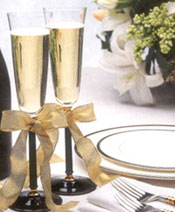

Sparkling wines vary greatly in quality, character and style. The French prototype, champagne, is imitated around the world. At its best champagne is dry but not austere, with a full but fine flavour coming from the use of classic grape varieties and from bottle-ageing.
Other sparkling wines vary from close competitors to champagne, made from the same grapes and in the same way, to wines which are closer to fizzy drinks: full of froth, sometimes with fresh fruit flavours, sometimes with little taste at all. The winemakers of Champagne are fiercely protective of their name; wines from anywhere else in the world made by the method traditionally used in Champagne are no longer allowed to use the term methode champenoise on their labels; look for the words methode classique (classic method), methode traditionelle (traditional method), or "fermented in bottle". All should denote quality wines made by the second-fermentation method.
Champagne may be the first choice for a celebration, but its price may render it prohibitive. All the sparkling wines listed here are above the basic, industrially-produced level and should not disappoint.
The first group — light, dry sparkling wines — all show regional identity and individuality. Most of the French and Spanish sparklers are made from more neutral-tasting grapes than is champagne and in consequence have less weight and perhaps more acidity.
Sparkling wines from Germany and Italy use more highly-flavoured grapes and tend to be medium, rather than dry, in taste. These wines are for drinking young and ice-cold, and are usually cheap enough to serve in quantity — the ultimate refreshers.
In the second group, the long-lasting taste, fineness of aroma, cleanness of style and length of finish of good champagne sets its competitors.
Other fine, dry sparkling wines are conscious imitators of champagne, although the New World is developing its own styles of sparkling wine as vineyards mature. New World wines tend to be fuller and softer than champagne, though with enough bottle-age they can show the same complex flavours of maturity.
Sweet sparkling wines range from the very light, Muscat-based wines of Italy to champagnes that have been made with additional dosage to taste sweet. These are often intended to accompany desserts, but beware: too sweet a pudding will overwhelm most wines: a dessert wine should always be a little sweeter than the dessert.
|
|
|




